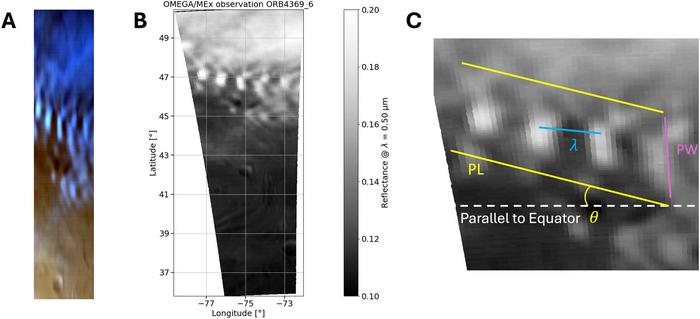The exploration of Mars has fascinated scientists and enthusiasts alike for decades, deepening our understanding of the Red Planet’s unique climate and atmospheric phenomena. A recent study titled “Atmospheric Gravity Waves in Mars’ Lower Atmosphere: Nadir Observations From OMEGA/Mars Express Data” sheds new light on the nature of atmospheric waves that traverse Mars’ atmosphere, highlighting their intricate patterns and significant implications for climate dynamics. Conducted by an international team of researchers, this study leverages two decades of data gathered by the OMEGA instrument aboard the European Mars Express spacecraft.
Atmospheric waves are disturbances that propagate through an atmosphere, analogous to waves on a water surface. These waves significantly impact atmospheric conditions, influencing temperature distributions, winds, and cloud formations. The study meticulously examined 263 groups of these atmospheric waves while delving into the details of 125 specific cases. Researchers focused on identifying a trio of major phenomena observed in mine Martian atmosphere: dry ice waves, water waves, and dust storms, each presenting unique challenges for analysis due to their differing visual signatures.
One of the most daunting challenges faced by the researchers was the identification of images that featured clouds among hundreds of thousands of photographs captured by Mars Express. Clouds on Mars are notoriously sparse and seldom seen, thus making the analysis heavily resource-intensive. Despite these hurdles, the team employed robust methodologies for selecting and analyzing images, ensuring that their findings maintained precision and accuracy.
The study highlights how atmospheric waves form differently on Mars compared to Earth, unveiling new aspects of Martian meteorology. Research leader Pedro Machado from the Faculty of Sciences at the University of Lisbon stated that the differences between the two planets are even more pronounced than previously thought. Notably, the study discovered a greater asymmetry in weather patterns between Mars’ northern and southern hemispheres than had been established in earlier research efforts.
By utilizing the OMEGA data, the researchers gained insights into the dynamics of climate systems that operate on Mars. These findings pave the way for better climate models, which can help predict how Martian weather patterns might evolve in the future. Understanding these atmospheric processes is vital, as it allows scientists to comprehend how energy fluctuations in the Martian atmosphere may affect its overall climate.
Following the initial findings of this research, the authors are further developing observational techniques that will facilitate a deeper analysis of Martian atmospheric waves. This involves gathering additional data and employing advanced methodologies to assess wind fields across the Martian landscape. By executing these complex analytical strategies, the team hopes to unravel even more mysteries contained within Mars’ lower atmosphere.
As the research progresses, there are significant implications for future missions to Mars. Detailed investigations into atmospheric waves could enhance the safety and effectiveness of human exploration initiatives by providing crucial information about Martian weather conditions, thereby equipping astronauts with the necessary insights to navigate and survive in this alien environment.
The study not only highlights the importance of international collaboration in space research but also exemplifies how cutting-edge technological advancements transform our understanding of alien worlds. With a diverse team composed of experts from various backgrounds and countries, the study exemplifies how collaboration can yield groundbreaking discoveries in the quest to better comprehend Mars.
In summary, this research is more than a collection of data; it is a comprehensive examination of atmospheric physics on Mars that opens the door to numerous exploration opportunities. The continuous analysis and method development executed by researchers Brazil and Machado promise to reinvent our interactions with Mars, providing a more refined understanding of its atmosphere. As they push the envelope of atmospheric science, they are enabling future generations of explorers to experience Mars more intimately and safely.
The direction of Martian atmospheric research has been transformed due to ambitious projects like these. Findings from this study mark a significant milestone in planetary atmospheric science, challenging prior assumptions while laying a foundation for subsequent explorations. As the international scientific community continues to unravel the enigmas surrounding Mars’ weather patterns, excitement builds for the additional revelations that await further scrutiny.
Moreover, the ongoing research might contribute significantly to comparative planetology, enabling scientists to establish connections between weather phenomena on Mars and those on other celestial bodies. This holistic understanding of atmospheres across various planets will deepen our comprehension of atmospheric science as a whole and could have profound implications for understanding climate change on Earth as well.
In conclusion, the recent study’s revelations serve as a stepping stone toward unveiling the complexities of Mars’ atmospheric behavior. As scientists probe deeper into the atmospheric mysteries of the Martian environment, we are reminded of the yet-unexplored territories awaiting discovery. The journey of scientific inquiry into Mars’ lower atmosphere is just beginning, with much more to learn about our neighboring planet’s climate systems and their larger implications for planetary science.
Subject of Research: Atmospheric waves in Mars’ lower atmosphere
Article Title: Atmospheric Gravity Waves in Mars’ Lower Atmosphere: Nadir Observations From OMEGA/Mars Express Data
News Publication Date: 4-Mar-2025
Web References: DOI link
References: None provided
Image Credits: F. Brasil, P. Machado, G. Gilli, A. Cardesín-Moinelo, J. E. Silva, D. Espadinha, L. Riu, J. Carter, C. Wilson
Keywords
Mars, atmospheric waves, climate dynamics, OMEGA, Mars Express, planetary science, meteorology, international research, exploration, dust storms, dry ice waves, water waves.




